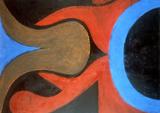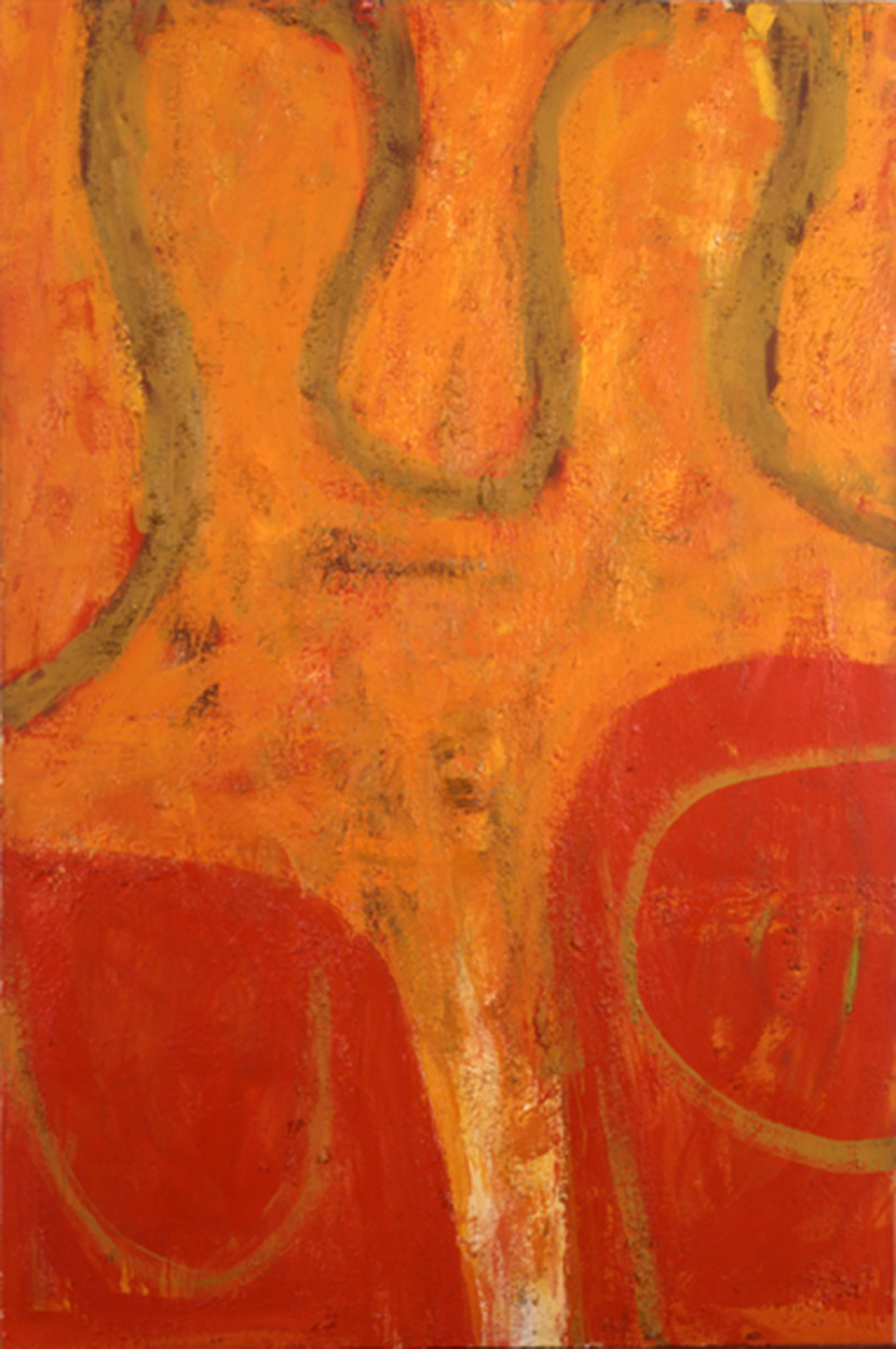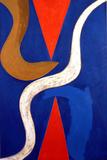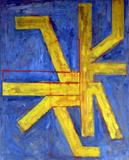Want more images or videos?
Request additional images or videos from the seller
1 of 10
Irene Zevon“Abstract, 1954”1954
1954
About the Item
Oil on canvas abstract painting by the American artist, Irene Zevon. Signed lower right and dated 1954. In very good condition. Not presently framed. Provenance: Estate of the artist, Nahum Tschacbasov.
Biography from The Benjaman Gallery
Irene Zevon, born in Brooklyn, was the first child in a Ukrainian family of working class immigrants. She began her art career in 1953 -- studying with Nahum Tschacbasov in New York City and Woodstock, New York. Tschacbasov studied with artists such as Leopold Gottlieb, Marcel Gromaire, and Fernand Leger, whose techniques were passed down to Zevon. Tschacbasov while teaching belonged to a group of ten artists, which included the likes of Mark Rothko and David Burliak. His circle of friends at the time included Stuart Davis, Milton Avery, the Soyer brothers and Marsden Hartley.
Irene Zevon and Nahum Tsachcbasov's relationship flourished, and in 1966 they wed. The couple lived seasonally in Amagansett and East Hampton; and year-round in their loft-like apartment at the Hotel Chelsea where they became part of the Chelsea art scene. Zevon resided, and had a studio for fifty years, in The Chelsea.
Zevon worked in a modernistic, lyrical abstract-figurative style in the mediums of oil and acrylic painting, linoleum block prints and monotype prints. Following her introduction to intaglio printmaking, she developed a unique linoleum / woodcut / stencil / monotype printing process in which three or more surface-printing techniques were used in non-traditional combinations. Concurrently, she created a collection of hand-crafted jewelry and powerful Etruscan-inspired ceramics.
Her artworks are in private and museum collections throughout the U.S. including the permanent collections of The San Fransisco Museum of Fine Art, Butler Art Institute, California State Library, Library of Congress, Columbus Museum of Arts and Crafts, Dallas Museum of Fine Arts, Library of Congress, St. Louis Museum of Art and University of Georgia Museum of Art.
- Creator:Irene Zevon (1916 - 2006, American)
- Creation Year:1954
- Dimensions:Height: 24 in (60.96 cm)Width: 16 in (40.64 cm)Depth: 1 in (2.54 cm)
- Medium:
- Movement & Style:
- Period:
- Condition:Old repair of tiny tear lower left.
- Gallery Location:Southampton, NY
- Reference Number:1stDibs: LU1414566231
About the Seller
4.9
Platinum Seller
These expertly vetted sellers are 1stDibs' most experienced sellers and are rated highest by our customers.
Established in 1977
1stDibs seller since 2013
464 sales on 1stDibs
Typical response time: 1 hour
- ShippingRetrieving quote...Ships From: Southampton, NY
- Return PolicyA return for this item may be initiated within 7 days of delivery.
More From This SellerView All
- “Untitled Abstract”By Nahum TschacbasovLocated in Southampton, NYOriginal mid-century modern abstract oil on canvas painting by the well known Russian/American artist Nahum Tschacbasov. Signed lower right and dated 1945. Condition is very good. P...Category
1940s Abstract Expressionist Abstract Paintings
MaterialsCanvas, Oil
- “Untitled”By John LittleLocated in Southampton, NYOriginal oil on canvas painting by the well known abstract expressionist artist, John Little. Signed lower right. Signed and dated 1965 on top stretcher bar verso. Betty Parsons Ga...Category
1960s Abstract Expressionist Abstract Paintings
MaterialsCanvas, Oil
- “Untitled”By John LittleLocated in Southampton, NYEarly, original oil on canvas painting by the well known American abstract expressionist artist, John Little. Signed and dated lower right, 1958. Signed and dated verso. Rose Fried...Category
1950s Abstract Expressionist Abstract Paintings
MaterialsCanvas, Oil
- “Gulfside”By Syd SolomonLocated in Southampton, NYOriginal, oil paint and acrylic paint on canvas by the well known American artist, Syd Solomon. Signed bottom middle by the artist. Titled and dated verso 1983. Condition is excellent. Original gallery floating frame. Overall framed measurements are 38 by 42 inches. Provenance: A Sarasota, Florida collector. SYD SOLOMON BIOGRAPHY Written by Dr. Lisa Peters/Berry Campbell Gallery “Here, in simple English, is what Syd Solomon does: He meditates. He connects his hand and paintbrush to the deeper, quieter, more mysterious parts of his mind- and he paints pictures of what he sees and feels down there.” --Kurt Vonnegut Jr. from Palm Sunday, 1981 Syd Solomon was born near Uniontown, Pennsylvania, in 1917. He began painting in high school in Wilkes-Barre, where he was also a star football player. After high school, he worked in advertising and took classes at the Art Institute of Chicago. Before the attack on Pearl Harbor, he joined the war effort and was assigned to the First Camouflage Battalion, the 924th Engineer Aviation Regiment of the US Army. He used his artistic skills to create camouflage instruction manuals utilized throughout the Army. He married Ann Francine Cohen in late 1941. Soon thereafter, in early 1942, the couple moved to Fort Ord in California where he was sent to camouflage the coast to protect it from possible aerial bombings. Sent overseas in 1943, Solomon did aerial reconnaissance over Holland. Solomon was sent to Normandy early in the invasion where his camouflage designs provided protective concealment for the transport of supplies for men who had broken through the enemy line. Solomon was considered one of the best camoufleurs in the Army, receiving among other commendations, five bronze stars. Solomon often remarked that his camouflage experience during World War II influenced his ideas about abstract art. At the end of the War, he attended the École des Beaux-Arts in Paris. Because Solomon suffered frostbite during the Battle of the Bulge, he could not live in cold climates, so he and Annie chose to settle in Sarasota, Florida, after the War. Sarasota was home to the John and Mable Ringling Museum of Art, and soon Solomon became friends with Arthur Everett “Chick” Austin, Jr., the museum’s first Director. In the late 1940s, Solomon experimented with new synthetic media, the precursors to acrylic paints provided to him by chemist Guy Pascal, who was developing them. Victor D’Amico, the first Director of Education for the Museum of Modern Art, recognized Solomon as the first artist to use acrylic paint. His early experimentation with this medium as well as other media put him at the forefront of technical innovations in his generation. He was also one of the first artists to use aerosol sprays and combined them with resists, an innovation influenced by his camouflage experience. Solomon’s work began to be acknowledged nationally in 1952. He was included in American Watercolors, Drawings and Prints at the Metropolitan Museum of Art, New York. From 1952–1962, Solomon’s work was discovered by the cognoscenti of the art world, including the Museum of Modern Art Curators, Dorothy C. Miller and Peter Selz, and the Whitney Museum of American Art’s Director, John I. H. Baur. He had his first solo show in New York at the Associated American Artists Gallery in 1955 with “Chick” Austin, Jr. writing the essay for the exhibition. In the summer of 1955, the Solomons visited East Hampton, New York, for the first time at the invitation of fellow artist David Budd...Category
1980s Abstract Expressionist Abstract Paintings
MaterialsCanvas, Oil, Acrylic
- “Lightride”By Syd SolomonLocated in Southampton, NYHere for your consideration is a great example of the artwork of the well known American artist, Syd Solomon. Signed top left. Titled and dated verso 1978. The painting is oil and acrylic paint on mounted synthetic canvas. Condition is excellent. Overall framed measurements are 44.75 by 24.5 inches. Provenance: A Sarasota, Florida collector. SYD SOLOMON BIOGRAPHY American 1917-2004 Written by Dr. Lisa Peters/Berry Campbell Gallery “Here, in simple English, is what Syd Solomon does: He meditates. He connects his hand and paintbrush to the deeper, quieter, more mysterious parts of his mind- and he paints pictures of what he sees and feels down there.” --Kurt Vonnegut Jr. from Palm Sunday, 1981 Syd Solomon was born near Uniontown, Pennsylvania, in 1917. He began painting in high school in Wilkes-Barre, where he was also a star football player. After high school, he worked in advertising and took classes at the Art Institute of Chicago. Before the attack on Pearl Harbor, he joined the war effort and was assigned to the First Camouflage Battalion, the 924th Engineer Aviation Regiment of the US Army. He used his artistic skills to create camouflage instruction manuals utilized throughout the Army. He married Ann Francine Cohen in late 1941. Soon thereafter, in early 1942, the couple moved to Fort Ord in California where he was sent to camouflage the coast to protect it from possible aerial bombings. Sent overseas in 1943, Solomon did aerial reconnaissance over Holland. Solomon was sent to Normandy early in the invasion where his camouflage designs provided protective concealment for the transport of supplies for men who had broken through the enemy line. Solomon was considered one of the best camoufleurs in the Army, receiving among other commendations, five bronze stars. Solomon often remarked that his camouflage experience during World War II influenced his ideas about abstract art. At the end of the War, he attended the École des Beaux-Arts in Paris. Because Solomon suffered frostbite during the Battle of the Bulge, he could not live in cold climates, so he and Annie chose to settle in Sarasota, Florida, after the War. Sarasota was home to the John and Mable Ringling Museum of Art, and soon Solomon became friends with Arthur Everett “Chick” Austin, Jr., the museum’s first Director. In the late 1940s, Solomon experimented with new synthetic media, the precursors to acrylic paints provided to him by chemist Guy Pascal, who was developing them. Victor D’Amico, the first Director of Education for the Museum of Modern Art, recognized Solomon as the first artist to use acrylic paint. His early experimentation with this medium as well as other media put him at the forefront of technical innovations in his generation. He was also one of the first artists to use aerosol sprays and combined them with resists, an innovation influenced by his camouflage experience. Solomon’s work began to be acknowledged nationally in 1952. He was included in American Watercolors, Drawings and Prints at the Metropolitan Museum of Art, New York. From 1952–1962, Solomon’s work was discovered by the cognoscenti of the art world, including the Museum of Modern Art Curators, Dorothy C. Miller and Peter Selz, and the Whitney Museum of American Art’s Director, John I. H. Baur. He had his first solo show in New York at the Associated American Artists Gallery in 1955 with “Chick” Austin, Jr. writing the essay for the exhibition. In the summer of 1955, the Solomons visited East Hampton, New York, for the first time at the invitation of fellow artist David Budd...Category
1970s Abstract Expressionist Abstract Paintings
MaterialsCanvas, Oil, Acrylic, Board
- “Dune Watch”By Syd SolomonLocated in Southampton, NYHere for your consideration is a very well executed early abstract painting by the well known American artist, Syd Solomon. Oil paint on birch ply panel. Signed middle bottom. Signed, titled and dated 1966 verso. The painting was done in East Hampton, New York where Syd Solomon spent his summers. Condition is excellent. Overall framed measurements are 26 by 31.5 inches. Provenance: A Sarasota, Florida collector. Syd Solomon was born near Uniontown, Pennsylvania, in 1917. He began painting in high school in Wilkes-Barre, where he was also a star football player. After high school, he worked in advertising and took classes at the Art Institute of Chicago. Before the attack on Pearl Harbor, he joined the war effort and was assigned to the First Camouflage Battalion, the 924th Engineer Aviation Regiment of the US Army. He used his artistic skills to create camouflage instruction manuals utilized throughout the Army. He married Ann Francine Cohen in late 1941. Soon thereafter, in early 1942, the couple moved to Fort Ord in California where he was sent to camouflage the coast to protect it from possible aerial bombings. Sent overseas in 1943, Solomon did aerial reconnaissance over Holland. Solomon was sent to Normandy early in the invasion where his camouflage designs provided protective concealment for the transport of supplies for men who had broken through the enemy line. Solomon was considered one of the best camoufleurs in the Army, receiving among other commendations, five bronze stars. Solomon often remarked that his camouflage experience during World War II influenced his ideas about abstract art. At the end of the War, he attended the École des Beaux-Arts in Paris. Because Solomon suffered frostbite during the Battle of the Bulge, he could not live in cold climates, so he and Annie chose to settle in Sarasota, Florida, after the War. Sarasota was home to the John and Mable Ringling Museum of Art, and soon Solomon became friends with Arthur Everett “Chick” Austin, Jr., the museum’s first Director. In the late 1940s, Solomon experimented with new synthetic media, the precursors to acrylic paints provided to him by chemist Guy Pascal, who was developing them. Victor D’Amico, the first Director of Education for the Museum of Modern Art, recognized Solomon as the first artist to use acrylic paint. His early experimentation with this medium as well as other media put him at the forefront of technical innovations in his generation. He was also one of the first artists to use aerosol sprays and combined them with resists, an innovation influenced by his camouflage experience. Solomon’s work began to be acknowledged nationally in 1952. He was included in American Watercolors, Drawings and Prints at the Metropolitan Museum of Art, New York. From 1952–1962, Solomon’s work was discovered by the cognoscenti of the art world, including the Museum of Modern Art Curators, Dorothy C. Miller and Peter Selz, and the Whitney Museum of American Art’s Director, John I. H. Baur. He had his first solo show in New York at the Associated American Artists Gallery in 1955 with “Chick” Austin, Jr. writing the essay for the exhibition. In the summer of 1955, the Solomons visited East Hampton, New York, for the first time at the invitation of fellow artist David Budd...Category
1960s Abstract Expressionist Abstract Paintings
MaterialsOil, Board
You May Also Like
- Untitled 14.34By Fritz BultmanLocated in New Orleans, LAFritz Bultman set himself apart from other Abstract Expressionists with his meticulously organized abstract compositions, use of sculpture, and the adoption of collage as a core prac...Category
Mid-20th Century Abstract Expressionist Abstract Paintings
MaterialsCanvas, Oil
- In AirBy Fritz BultmanLocated in New Orleans, LAFritz Bultman (1919-1985) was an American Abstract Expressionist painter, sculptor, and collagist and a member of the New York School of artists. He was born in New Orleans, Louisiana and moved to Germany to join the Bauhaus at the age of 16. There, he was acquainted with Maria Hofmann, the wife of Hans Hofmann, which initiated a move to New York to study under his guidance. Bultman set himself apart from other Abstract Expressionists with his meticulously organized abstract compositions, use of sculpture, and the adoption of collage as a core practice. In 1950, Fritz Bultman and 27 other distinguished artists signed a letter protesting the conservative nature of the work selected for a forthcoming national exhibition at the Metropolitan Museum of Art. The signees of this historic letter were identified as, the “Irascibles,” resulting in the majority achieving international acclaim as Abstract Expressionist artists including Willem de Kooning, Robert Motherwell, Jackson Pollock, and Mark Rothko, among others. Throughout his life Fritz Bultman received several awards including Fulbright and Guggenheim Fellowships and was a founding member of the Long Point...Category
Mid-20th Century Abstract Expressionist Abstract Paintings
MaterialsCanvas, Oil
- King ZuluBy Fritz BultmanLocated in New Orleans, LAFritz Bultman set himself apart from other Abstract Expressionists with his meticulously organized abstract compositions, use of sculpture, and the adoption of collage as a core prac...Category
1950s Abstract Expressionist Abstract Paintings
MaterialsCanvas, Oil
- SeawormBy Fritz BultmanLocated in New Orleans, LAFritz Bultman set himself apart from other Abstract Expressionists with his meticulously organized abstract compositions, use of sculpture, and the adoption of collage as a core prac...Category
1970s Abstract Expressionist Abstract Paintings
MaterialsCanvas, Oil
- SwimmerBy Fritz BultmanLocated in New Orleans, LAFritz Bultman set himself apart from other Abstract Expressionists with his meticulously organized abstract compositions, use of sculpture, and the adoption of collage as a core prac...Category
1940s Abstract Expressionist Abstract Paintings
MaterialsCanvas, Oil
- The Good News II / Depart (Paris)By Fritz BultmanLocated in New Orleans, LAFritz Bultman set himself apart from other Abstract Expressionists with his meticulously organized abstract compositions, use of sculpture, and the adoption of collage as a core prac...Category
Mid-20th Century Abstract Expressionist Abstract Paintings
MaterialsCanvas, Oil
Recently Viewed
View AllMore Ways To Browse
Abstract Jewellery
1950 S Abstract Paintings
Circle Of Friends
Abstract Art Non Figurative
Vintage Circle Of Friends
Vintage Irene
Painting By Milton Avery
Child Studying Library
Louis Congress
Soyer Oil
Brothers Fine Jewelry
St Leger
Retro Printing Blocks
Hartley Marsden
Used Jewelry Dallas
Round Intaglios
Georgian Intaglio
Amagansett Painting





